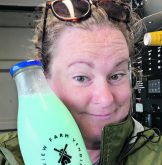Leaving the farm was a 10-year process for Brent and Pam Sattler.
The couple, now retired from their Milestone, Sask., farm to a home in Warman, said it’s never too early to start thinking about a succession plan or an exit strategy.
They began farming in 1986 on land Brent’s grandparents had moved to in 1924. At first they farmed from a distance and in 1990 moved to the property.
“In later years we took over my uncle and cousin’s operation at Wilcox as well, so we had about 30 kilometres end-to-end on the operation,” Brent said.
Read Also

Alberta cracks down on trucking industry
Alberta transportation industry receives numerous sanctions and suspensions after crackdown investigation resulting from numerous bridge strikes and concerned calls and letters from concerned citizens
It totaled about 4,500 acres.
Also in 1990, Pam’s parents retired from their farm near Lloydminster and came to help the younger couple and spend time with their grandchildren, Kyle and Kelvin. It was a 14-hour round trip.
“They were our free labour for the next 10 years,” said Pam.
As with many farm families, the day-to-day work was their priority.
Pam said in 2012 she kept seeing advertisements about a succession course offered by the provincial government and realized they hadn’t considered the future.
“Initially I just took the course and they said, ‘You know, you should really start having an exit plan as soon as you start a business,’” she said.
A ‘Taking Stock’ questionnaire galvanized them to think about long-term goals and what their lives would look like down the road.
Brent said if that course hadn’t come along they probably would have stalled longer.
“I can’t stress enough that time is everything in this business,” he said. “On the farm you just dig in, you get stuff done, it happens really quick. (Succession) is not something that happens quickly.
“One of the takeaways I have from this whole process is you can’t start early enough because sometimes it means even a change in the format or the way your corporation is set up.”
Pam said she and Brent, who both have degrees in engineering, are methodical planners and have always known their strengths and weaknesses. They never shied away from seeking professional advice where needed, and in 2015 took advantage of some Growing Forward funding to hire Ray Riel, from Advice Only Financial.
Riel is a rarity in the world of financial planning in that he doesn’t sell products. He grew up on a farm, owned several businesses and worked as a financial planner before recognizing the unique needs that farmers have in transitioning their operations either within or outside the family.
Although the initial plan was for one of the Sattlers’ sons to take over the farm, that changed when some health issues arose. Riel switched gears to help them with an exit strategy.
He said many farmers don’t realize how many options they have, but the first thing to consider is what is most important. It isn’t always the money.
“Sometimes when you’re exiting it’s as much an emotional event as it is a financial event,” Riel said. “Sometimes in the process we get tangled up on the financial side and we forget about what really should be a priority and giving some thought to the emotional side.”
Pam said that was a challenge, particularly when they were in the succession planning stage.
“I think we’re actually both quite sentimental and that was some of the more difficult part,” she said. “All the memories are tied up there and any time I would try to express how I felt about that, I really felt like the kids felt I was trying to push them into taking over the farm.”
Brent said it wasn’t hard for him to recognize that change was coming and that a process would be followed, but it was difficult not knowing what their sons and families wanted.
“I’m not a great communicator face to face so that’s the thing that concerned me the most,” he said. “Somehow that communication has to happen, and it has to happen concisely.”
Once it became apparent that they were going to sell the operation, the process unfolded under Riel’s guidance.
The Sattlers had a list of priorities: they preferred to sell everything as a unit to a local younger farm family; they didn’t want to parcel off the land and be left with a landlocked yard that wouldn’t be functional; and they wanted a reasonable return for 98 years of work by three generations, but not necessarily the highest offer.
Riel told them their options included listing the farm with a realtor and having an auction, selling the operation as turnkey, selling the equipment and renting the land on a cash basis, and more.
He said what Brent and Pam did is a bit unusual in that they hand-picked their buyer ahead of time. They asked Riel to find out if the other family was interested and then to follow up.
A total farm asset appraisal completed in February 2020 was critical in establishing a value at which they would be comfortable selling.
“Ray went to the prospective buyers and asked what they might be willing to pay, and they came back with the identical number,” said Pam.
Brent said the appraisal can be expensive but it’s good peace of mind.
“I’m sitting here today and I don’t have any regrets about did we ask enough for this or did we get sufficient value of that,” he said.
The couple said they relied on their accountants, lawyers and Riel to choose a sales option that would minimize tax burden and maintain integrity. Their land and buildings were mostly held in their joint corporation, in which they are the sole owners, but some was individually held, which added to the complexity of the transaction.
At the same time, they had no debt so that eased the deal.
Initially, the potential buyers only wanted the land, but through the process learned there was value in infrastructure such as the seed cleaning plant. After a severe windstorm in January 2020, they had even helped the Sattlers after three overhead doors blew out on the farm shop.
“They had a sufficient labour base to be able to just take over,” said Pam. “Brent did some training with the cleaning plant. We were hopeful that someone would live in the house and somebody did move in.”
The equipment was sold at auction, with the final pieces going after the last of the grain was moved last spring.
The Sattlers took possession of their new home in July 2020 and moved in slowly, by the carload or truck-and-trailer load until June 2021.
Brent built a huge shop in their new backyard where he is working to restore some of his family’s antique farm equipment. He even got a farming fix by helping a nearby farmer this past harvest.
Pam has set up a sewing room and said she wants to spend time with her mom. They are also closer to their boys and their families.
They both say the process took time but turned out exactly as they wanted.
“It was an absolute priority to us, when we were starting the process, to have someone that lives in the community, participates in the community and someone that we felt could operate the operation,” said Brent. “It turned out extremely well for us.”
Four takeaways:
- Start the process early. You don’t know what’s going to come up that could take longer and if there is a transitional change in corporate structure, it takes more time.
- Stay focused on end goals through the whole process. Keep that goal constantly in mind while working on the transition and maintain common sense in every decision.
- Recognize your strengths and weaknesses. Seek professional help. Start early so you can develop trust and understanding with the people who are assisting.
- Maintain concise communications with all parties throughout the process. It’s hard to communicate with someone you may not know well enough but it’s necessary.
















